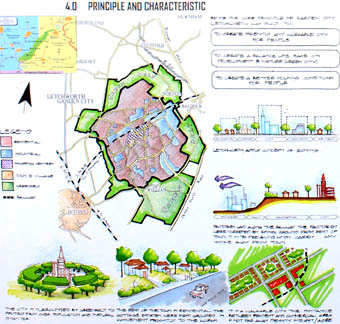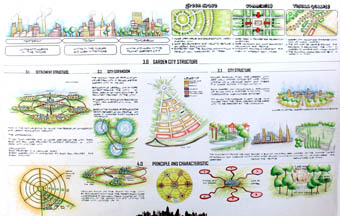|
Garden City 4
 eerste hoofdmenu
eerste hoofdmenu
Principe van een Garden City


klik voor een
vergroting.
Garden cities were the brainchild of Sir Ebenezer
Howard, a native of London and born to a middle class
family. He pursued a variety of careers including farming,
office work and a lifetime of various inventions. A deep
thinker, Howard published two editions of his work:
To-morrow: A Peaceful Path to Real Reform and Garden Cities
of Tomorrow.
The pollution and overcrowding that resulted from the
industrial revolution generated Howard's interest in finding
solutions to modern social ills. Howard wanted to fit a
fully functioning community into a compact, self-sustaining
and easily replicable design. The pattern was focused on a
central hub of industrial and commercial activity with
branches stemming from the center.


This organic type of growth was to house no more than
30,000 people in approximately 6,000 acres. A main
transportation route connected each branch. Stops were
located in the center of activity, connecting each area.
All income levels were to be represented. Low and upper
class citizens would find suitable housing fairly close to
each other. However, private ownership of land was not
provided for. The monies for rent first paid the debts of
construction and infrastructure before being reinvested into
the community. There were other big
differences.


Businesses were monopolistic in garden cities. As new
growth happened, the same owners were to franchise into the
new hubs. Government buildings were held in special regard
and were given the most accessible and prominent locations.
Farmland was also held in high regard totaling over
three-quarters of the land.


Omhoog
-  - - - - - -
- - - - - -
 eerste hoofdmenu
eerste hoofdmenu
|